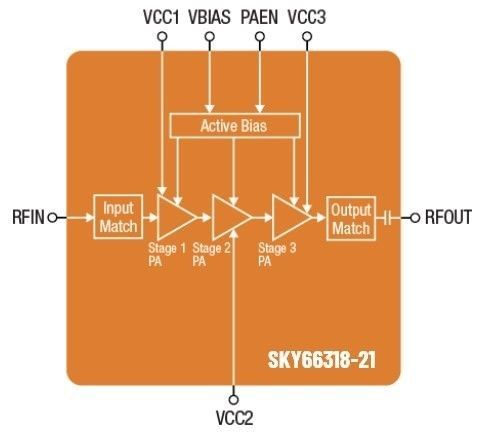This article was initially published on November 18, 2020
The Power Efficiency Challenge for Next-Generation Radios
The evolution of wireless standards has seen a dramatic increase in spectral efficiency and data rates as shown in the table below. New and complex modulation schemes along with increased bandwidth in the radio are delivering peak data rates of up to 1 Gbit/s for sub-6 GHz wireless access.

However, the increased spectral efficiency has come at the cost of poorer energy efficiency for the radio, which is due to the nature of the LTE and 5G waveforms. In order to achieve higher spectral efficiency or more data bits per symbol, the resulting waveforms have a high peak to average power ratio (PAPR) as shown in the diagram below. This kind of waveform results in poor average efficiency for the fixed supply RF power amplifier (PA) with most of the power drawn from the supply dissipated as heat in the radio. The PAs now consume over 50 percent of all the power consumed in the radio and are a major driver of the size, weight, and OPEX for mobile network operators.

Xilinx offers highly adaptable IP to address this energy efficiency challenge in the radio. The IP can be configured and scaled to address a wide range of use cases from small cell and massive MIMO panels to high-power macro radios. Power amplifier technology also continues to evolve to support wider bandwidths and take advantage of the latest semiconductor technologies. Being able to adapt and track the latest radio requirements is a key benefit of this approach. The Xilinx radio platform (silicon and IP) can scale and adapt for faster time to market with the lowest TCO for mobile network operators.
Below is a video of a demonstration of Xilinx's latest Crest Factor Reduction (CFR) and Digital Pre-Distortion (DPD) IP together with an RF transceiver from Texas Instruments and a 28dBm high-efficiency PA from Skyworks. The line-up is typical of a small cell radio with support for up to four antennas. Here we see how Xilinx's Adaptable RF IP can easily scale to achieve 100MHz and 200MHz bandwidth performance for the same line-up.
AFE7769 RF Transceiver from Texas Instruments
The AFE7769 offers four transmit, four receiving, and two observation receiver paths for wideband RF applications. Each transmit and observation path can support up to 600 MHz of signal bandwidth, while each receiver path enables 200MHz signal bandwidth with high performance.

Features
- Low-power, zero-IF transceiver
- 4T4R2F
- Output RF up to 6 GHz
- Up to 600 MHz Tx bandwidth
- Up to 200 MHz traffic Rx RF bandwidth
- Feedback path
- DPD FB (up to 600 MHz bandwidth)
- Third-order DPD correction for 200 MHz bandwidth
- 8x 29.5 Gbps JESD204B/C SerDes
- 17x17mm BGA package, 0.8-mm pitch
SKY66318-21 28dBm High-Efficiency Power Amplifier from Skyworks
This device is optimized for ACLR compliance and high efficiency using a 200 MHz bandwidth 5G signal in the 3300-3700 MHz frequency range. It is part of the Skyworks family of 5x5 mm small cell high-efficiency power amplifiers.

Features
- Frequency Range 3300-3700 MHz
- Wide instantaneous signal bandwidth: 200 MHz
- High efficiency
- High linearity: 3GPP compliant with 200MHz 5G, 8.5dB PAR signal
- High gain
- Integrated enable on/off function
- Single supply voltage: 5.0 V
- Compact (16-pin, 5 x 5 x 1.3 mm) package
For more information
- Zynq Ultrascale+ MPSoC
- Texas Instruments AFE7769 RF Transceiver
- Skyworks SKY66318 RF Power Amplifier